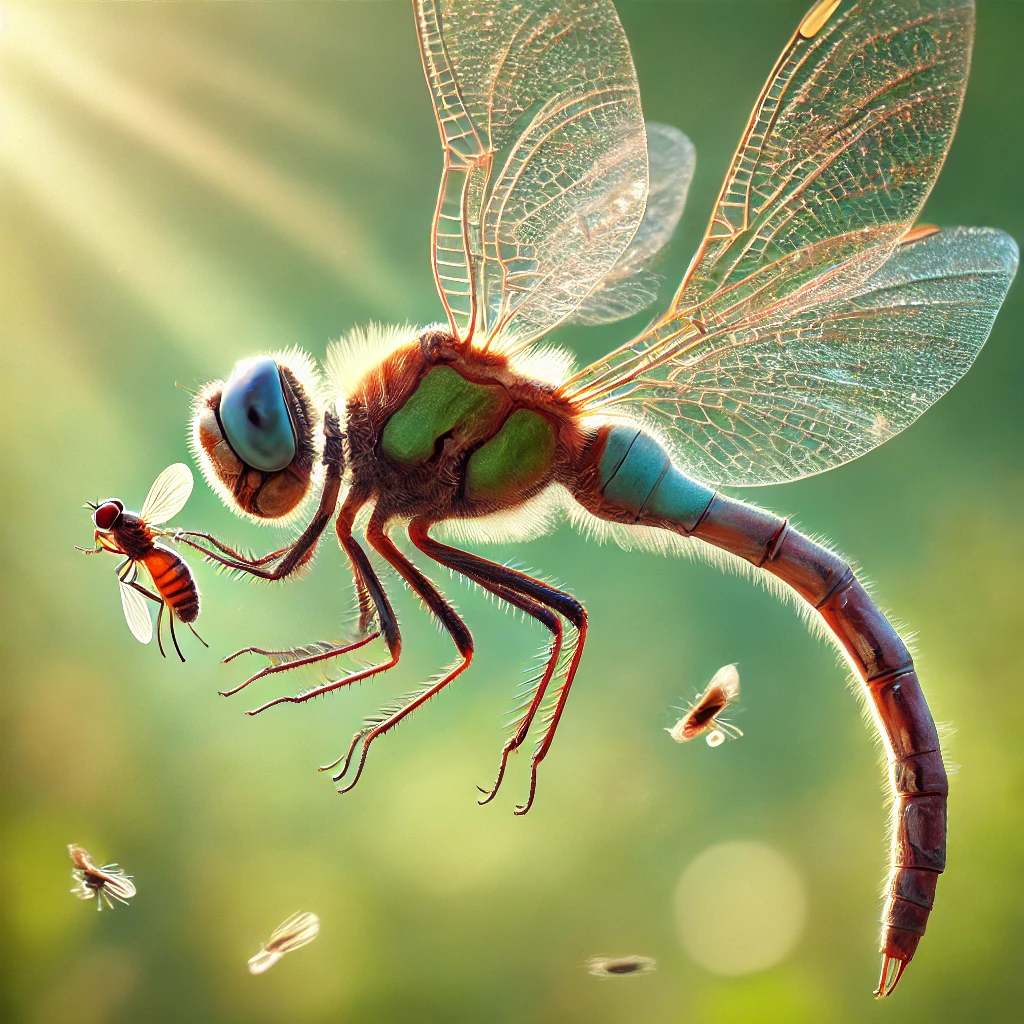What Do Dragonflies Eat?
Dragonflies, known for their agile flight and vivid colors, play a crucial role in the ecosystem as expert predators. Their diet and hunting skills help control insect populations and maintain a balanced ecosystem. In this blog, we explore what dragonflies eat, how they catch their prey, and the impact they have on their surroundings.
1. The Diet of Dragonflies: Carnivorous Predators
Dragonflies are strictly carnivorous, meaning they consume only animal matter. They eat a variety of small insects, many of which are pests to humans. Their diet includes:
- Mosquitoes: Dragonflies are known for their appetite for mosquitoes, consuming both adults and larvae. This diet benefits humans by helping to control mosquito populations.
- Flies and Gnats: Dragonflies catch flies and gnats mid-air with remarkable speed and accuracy. These insects are small and easy to catch, making them a staple in the dragonfly diet.
- Bees and Butterflies: While dragonflies primarily consume smaller insects, they also eat bees and butterflies. They target these insects based on availability rather than preference, making them opportunistic feeders.
- Other Dragonflies: Dragonflies sometimes exhibit cannibalistic behavior, preying on smaller or weaker dragonflies. This is especially common among young or territorial individuals.
- Other Small Insects: Dragonflies may also eat ants, termites, and other small insects they find in their habitats, adding variety to their diet and supporting their nutritional needs.
2. How Dragonflies Hunt: Precision and Agility
Dragonflies rely on advanced hunting skills that make them one of nature’s most efficient predators. They use a combination of excellent vision, agile flight, and strong legs to catch prey mid-flight.
- Incredible Eyesight: Dragonflies have large, compound eyes that provide nearly 360-degree vision. They can detect even the slightest movement from a distance, making it nearly impossible for insects to escape their notice.
- Aerial Agility: With two pairs of independently moving wings, dragonflies perform complex maneuvers to chase and capture prey mid-flight. They can hover, pivot, and accelerate rapidly, matching the unpredictable flight of their prey.
- Prehensile Legs: Dragonflies use their long, strong legs to form a basket-like shape that captures insects. As they approach prey, they scoop it up and hold it securely until they’re ready to eat.
3. Life Stages of a Dragonfly: Diet from Nymph to Adult
Dragonflies undergo a transformation called incomplete metamorphosis, progressing from aquatic nymphs to flying adults. Each stage of their life brings different dietary needs and hunting techniques:
- Dragonfly Nymphs: Nymphs, or larvae, live in freshwater environments and eat small aquatic organisms, including mosquito larvae, worms, and even small fish or tadpoles. Nymphs use a unique, extendable jaw called a “labium” to catch and devour prey quickly. They stay in this stage for months or even years, feeding on anything they can catch underwater.
- Adult Dragonflies: As adults, dragonflies transition to a diet of flying insects. They lose their labium but gain agile wings, powerful eyesight, and new hunting skills. Adults live shorter lives than nymphs, often surviving only a few weeks to a few months, during which they feed voraciously to fuel their high-energy lifestyles.
4. Impact of Dragonflies on Ecosystems
Dragonflies play a vital role in their ecosystems by controlling insect populations. Their diet helps maintain balance, especially in wetland areas where mosquitoes and other insects thrive.
- Natural Pest Control: By consuming large numbers of insects, dragonflies act as natural pest controllers. They help reduce mosquito populations, benefiting both human health and comfort, particularly in regions with high mosquito density.
- Biodiversity Support: Dragonflies contribute to biodiversity by influencing the populations of various insects. Their predation helps prevent any single insect species from dominating the ecosystem, which promotes a balanced environment.
- Indicator Species: Because dragonflies live in both aquatic and terrestrial environments, they serve as indicators of ecosystem health. A healthy dragonfly population suggests a balanced, uncontaminated environment, while declines in their numbers may indicate pollution or habitat loss.
5. Human Interaction with Dragonflies
Humans benefit from dragonflies’ natural pest control capabilities, and many people enjoy watching their graceful flight. In some cultures, dragonflies carry symbolic meanings related to adaptability and transformation, adding to their appeal. While dragonflies do not pose any threat to humans, conserving their habitats benefits both humans and ecosystems.
Frequently Asked Questions About Dragonfly Diets
- How many insects do dragonflies eat daily?
A single dragonfly can eat several dozen to hundreds of insects daily, depending on its size and the availability of prey. - Do dragonflies only eat mosquitoes?
No, while dragonflies are famous for eating mosquitoes, they also consume various other insects, such as flies, gnats, bees, and even other dragonflies. - Can dragonflies help reduce mosquito populations?
Yes, dragonflies can help control mosquito populations by consuming large numbers of mosquitoes, especially in areas near water where mosquitoes breed.
Final Thoughts
Dragonflies, as skilled predators, contribute to maintaining ecological balance by feeding on insects that would otherwise disrupt ecosystems or become nuisances. Their diet of mosquitoes, flies, and other insects makes them valuable allies for natural pest control, and their hunting techniques showcase incredible adaptations. By understanding what dragonflies eat and their ecological impact, we can better appreciate these beautiful, agile insects and the role they play in the natural world.






